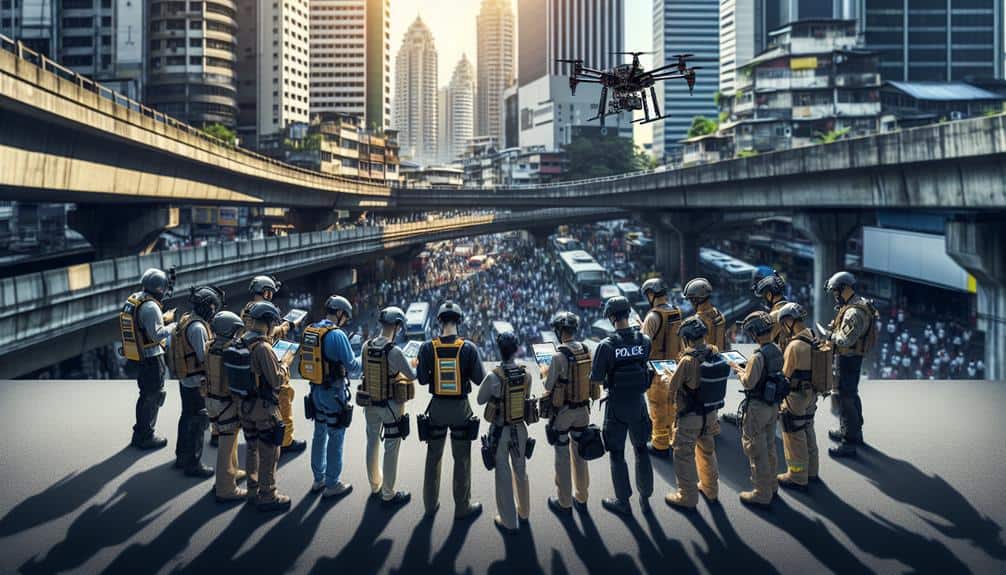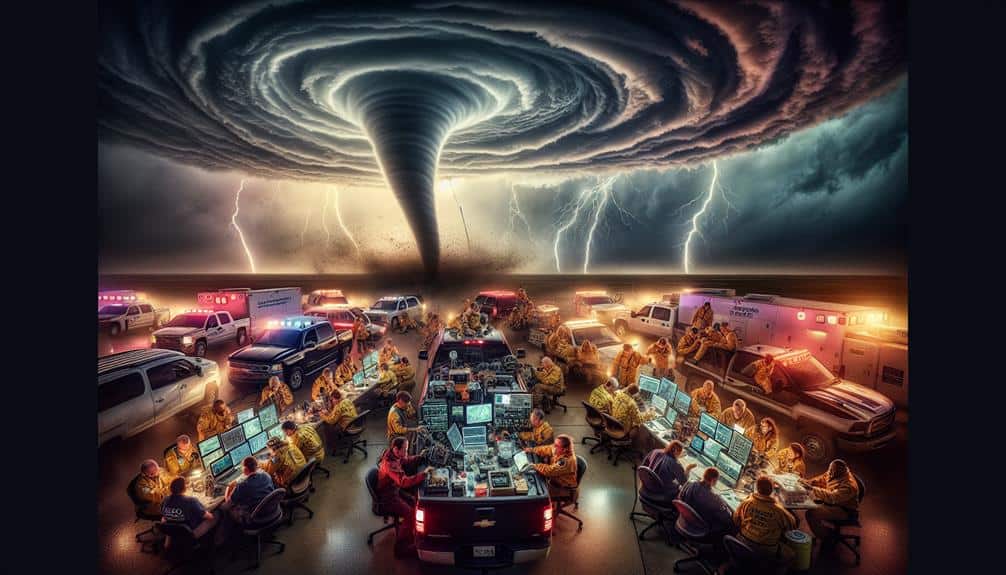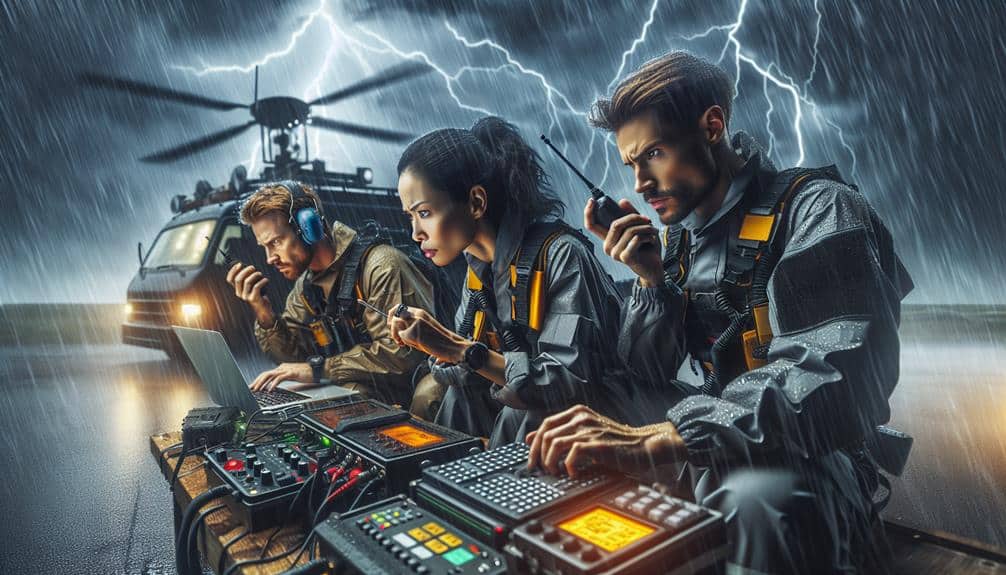We achieve peak safety and efficiency in emergency response by leveraging storm dynamics for accurate tracking and timely actions. Rigorous training guarantees our teams are skilled and ready, while advanced equipment and technology like drones and portable medical devices enhance operational capabilities. Effective real-time communication enables swift, coordinated efforts, and robust risk assessment protocols prioritize resource allocation during crises. Post-event analysis and continuous improvement help refine our strategies, guaranteeing we're always prepared for future challenges. If you're interested in understanding the full scope of our approach, there's much more to explore.
Key Points
- Implement real-time storm tracking for accurate evacuation and resource allocation.
- Conduct rigorous training and simulation exercises to enhance team readiness.
- Utilize cutting-edge equipment and technology for efficient disaster response.
- Ensure robust, clear, and immediate communication during emergencies.
Understanding Storm Dynamics
To effectively respond to emergencies, we must first understand the intricate dynamics of storm systems. By analyzing storm tracking and weather patterns, we can predict the potential impact of various storm types. This allows us to implement emergency protocols that are both timely and effective.
Tracking storms involves monitoring data from satellites, radars, and other meteorological tools that provide real-time updates on weather conditions. Understanding these patterns helps us determine the severity and trajectory of a storm, which in turn informs our evacuation procedures. When a storm's path is clearly mapped, we can alert affected areas and guide residents to safety well in advance.
Emergency protocols rely heavily on accurate storm tracking. The moment we detect an impending storm, we activate our response plans, ensuring that emergency services are on standby and evacuation routes are clear. Detailed knowledge of weather patterns also aids in resource allocation, ensuring that shelters are adequately equipped and emergency personnel are strategically positioned.
In essence, our comprehension of storm dynamics directly influences our ability to safeguard lives and property. By mastering these elements, we enhance our emergency response, granting communities the freedom to react swiftly and effectively.
Training and Preparedness
How can we guarantee our emergency response teams are prepared for any situation? The key lies in rigorous training and preparedness. We need to focus on simulation exercises and hands-on training to build a strong foundation for our teams. These methods provide realistic environments where responders can practice and refine their skills. By engaging in emergency response drills, we make sure that teams aren't only familiar with standard procedures but also capable of adapting to unexpected challenges. Scenario preparation is vital; it allows us to anticipate various situations and develop flexible, effective strategies.
It's important that our training programs incorporate a wide range of possible emergencies, from natural disasters to human-made crises. Regularly scheduled drills help maintain a high level of readiness and guarantee that our response teams remain sharp. We should also encourage feedback and continuous improvement, making adjustments based on lessons learned during these exercises.
Ultimately, our goal is to create a culture of readiness where every team member feels confident and empowered to act decisively. By prioritizing inclusive training and realistic scenarios, we can enhance both the safety and efficiency of our emergency response efforts, ensuring freedom and security for all.
Equipment and Technology
Our emergency response teams' effectiveness relies on the cutting-edge equipment and technology we provide them. High-quality tools and innovative devices are essential in guaranteeing both safety and efficiency during critical operations. We must prioritize equipment maintenance, as it's crucial to keep all gear in top condition. Regular inspections and timely repairs can prevent malfunctions that could jeopardize lives.
Technology advancements have revolutionized emergency response, offering new solutions for old challenges. For example, drones equipped with thermal imaging can quickly locate survivors in disaster zones, greatly reducing search and rescue times. Portable medical devices, such as automated external defibrillators (AEDs) and advanced trauma kits, are indispensable for immediate, on-site medical intervention.
We also leverage sophisticated software for resource management and logistics, ensuring that our teams are always well-equipped and strategically deployed. GPS tracking systems and real-time data analytics enable us to make informed decisions swiftly, adapting to dynamic situations.
Investing in state-of-the-art technology not only enhances our operational capabilities but also empowers our teams by providing them with the tools they need to perform their duties effectively. By staying ahead with the latest advancements and maintaining our equipment rigorously, we guarantee top performance in every emergency scenario.
Real-Time Communication
Effective real-time communication is essential for coordinating emergency response efforts and guaranteeing team safety. When we're in the midst of a crisis, clear and immediate communication allows us to make informed decisions swiftly. It's the backbone of effective incident management, enabling us to relay critical information and adapt to evolving situations in real time.
To achieve this, we need robust communication systems that integrate seamlessly with our emergency protocols. These systems should include encrypted radios, mobile data terminals, and integrated software platforms that provide real-time updates and situational awareness. Our teams must be trained not just in the use of these tools, but also in the protocols that guarantee messages are clear, concise, and actionable.
Moreover, interoperability between different agencies and departments is essential. We often find ourselves collaborating with various entities, and standardized communication protocols help us overcome potential language and procedural barriers. This ensures that everyone involved in the response is on the same page, reducing confusion and enhancing our collective efficiency.
Risk Assessment Protocols

In our risk assessment protocols, we must first identify potential hazards that could compromise safety.
Next, we prioritize these risk factors based on their severity and likelihood.
This systematic approach guarantees we allocate resources efficiently and respond effectively during emergencies.
Identifying Potential Hazards
Identifying potential dangers involves a thorough evaluation of environmental, operational, and procedural risks to guarantee safety and efficiency in emergency response. We start with meticulous risk identification to pinpoint all possible threats. This includes natural disasters, chemical spills, structural failures, and human errors. Each hazard must be documented and categorized, allowing us to conduct a detailed hazard evaluation.
We employ advanced tools and technologies to gather data on potential risks. Drones, for instance, provide aerial views of disaster zones, highlighting areas of concern that might be overlooked from the ground. Environmental sensors detect hazardous materials or unstable conditions, making sure we're informed of threats before they escalate.
Operational risks, such as equipment malfunctions or communication breakdowns, require constant monitoring. Regular drills and simulations help us identify weak points in our procedures. By evaluating these risks, we can refine our protocols and guarantee our teams are prepared for any scenario.
Procedural risks involve evaluating the steps we take during an emergency. Are our evacuation routes clear? Are our response times optimized? By examining every detail, we guarantee our procedures aren't just effective but also adaptable.
This rigorous approach to identifying potential hazards enables us to maintain a high standard of safety and efficiency in our emergency responses.
Prioritizing Risk Factors
After documenting and categorizing potential hazards, we must prioritize these risks to allocate resources effectively and enhance our response strategies. Our first step in risk assessment involves evaluating the likelihood and potential impact of each hazard. We need to ask ourselves: Which risks are most probable? Which have the highest potential for harm?
To streamline this process, we use a matrix that scores risks based on severity and frequency. High-severity, high-frequency risks get top priority. For instance, a chemical spill in a densely populated area would rank higher than a minor electrical issue in an isolated building. By doing this, we secure our emergency protocols are both proactive and responsive.
Next, we assign resources accordingly. High-priority risks receive more personnel, equipment, and training. This targeted allocation secures that our emergency response teams are well-prepared to handle the most critical situations first.
Additionally, we continuously update our risk assessment based on new data and evolving threats. This dynamic approach allows us to adapt quickly, maintaining a high level of safety and efficiency.
Post-Event Analysis
Thorough post-event analysis allows us to identify vital areas for improvement and enhance future emergency response efforts. By systematically reviewing each aspect of the response, we can uncover valuable lessons learned and formulate effective improvement strategies. This process is essential for refining our methods and making sure that we're better prepared for the next emergency.
We start by collecting data from all involved parties, including first responders, support staff, and affected individuals. This inclusive approach ensures we don't miss any crucial insights.
Next, we analyze this data to pinpoint what worked well and what didn't. For instance, if we faced delays due to communication breakdowns, we can focus on upgrading our communication systems or providing additional training.
Furthermore, we should document our findings and share them with all stakeholders. Transparency in our process fosters a culture of continuous improvement and accountability.
Implementing the identified improvement strategies, such as enhancing resource allocation or revising evacuation plans, directly contributes to our overall efficiency and safety.
Frequently Asked Questions
How Can Communities Support Emergency Responders Before and During a Crisis?
Think of us as a ship's crew; community involvement is our compass. Pre-crisis preparation guarantees we're ready when storms hit. By training, volunteering, and staying informed, we can support our emergency responders effectively during crises.
What Are the Psychological Impacts on Emergency Responders?
We recognize that emergency responders face significant psychological impacts. Mental health challenges and stress management are key issues. Addressing these effectively is essential to ensuring their well-being and maintaining their ability to perform at their best under pressure.
How Do Funding and Budget Constraints Affect Emergency Response Efforts?
When we faced financial challenges during the wildfire season, resource allocation suffered. We couldn't deploy enough crews or equipment, which delayed containment efforts and increased risks. Budget constraints directly impact our effectiveness and community safety.
What Role Does Public Awareness Play in Emergency Response Success?
Public awareness plays an essential role in emergency response success. Through community engagement and training programs, media campaigns and preparedness initiatives, we empower individuals to act promptly and effectively, enhancing overall safety and efficiency.
How Do Emergency Response Teams Handle Language Barriers in Diverse Communities?
We address language barriers by employing cultural sensitivity and effective communication strategies. We use translation services, bilingual staff, and visual aids to guarantee everyone understands critical information, promoting safety and inclusivity in diverse communities.


